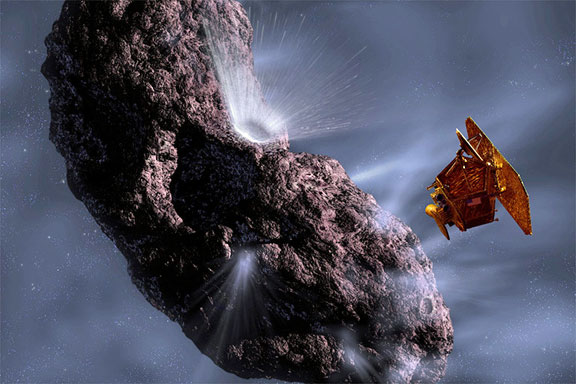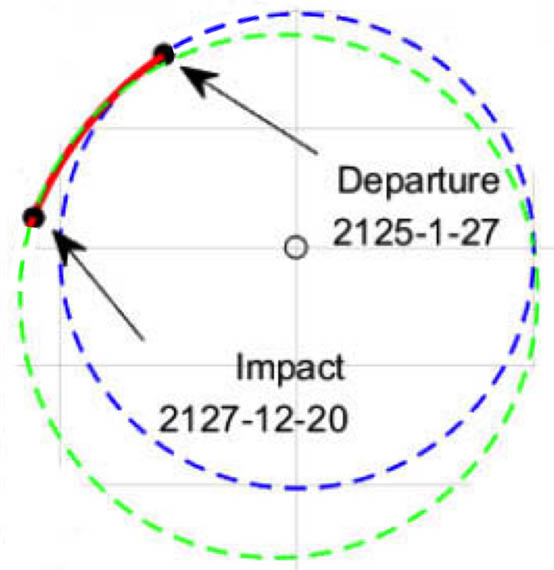|
Asteroids pose an existential threat to all life on Earth, as demonstrated by the “K-T” mass extinction event, in which 75% of all plant and animal species perished — see my Feb. 2019 newsletter that focused on asteroid detection. It is estimated the K-T asteroid was 10 to 15 km (6 to 9 miles) wide.
 If you are not sure asteroids are a problem, look at this image from NASA/Caltech/JPL that shows Earth’s orbit (white circle) and the positions of all known asteroids. If you are not sure asteroids are a problem, look at this image from NASA/Caltech/JPL that shows Earth’s orbit (white circle) and the positions of all known asteroids.
Now, let’s explore a leading scheme to protect all of us from another catastrophic asteroid impact — this is the body-blow method, officially called kinetic impact.
In this scheme, we launch spacecraft to crash into a threatening asteroid and change its trajectory. If the impactors are massive enough, hit with high enough velocity, and hit early enough, even a slight velocity change will prevent the asteroid from hitting Earth.

This artist’s sketch, shows NASA’s Deep Impact hitting comet Tempel 1. The impactor had a 372 kg (820 lbs) mass, and a relative velocity of 10.2 km/s (22,000 mph). It changed the comet’s velocity by only 0.001 mm/s. Tempel 1 is about 6 km (3.6 miles) wide.
We need to do much better — the minimum velocity change to avoid impact is (35 mm/s)/t, where t is the time in years that the deflection occurs before the otherwise expected Earth impact.
In 2021, DART, a NASA / ESA (European Space Agency) collaboration, will launch a rocket to strike the smaller partner of the binary asteroid Didymos with a 555 kg impactor at a relative velocity of 6.65 km/s, hoping to change its velocity by 0.8 mm/s — more if a large amount of material is ejected from the impact crater, thereby increasing the total kick.
Normally, spacecraft are launched atop multi-stage rockets. As each engine/fuel-tank stage is spent, it is jettisoned to lighten the load. Ultimately only the spacecraft itself remains, carrying its crew or cargo to the destination.
However, in an asteroid deflection mission, we want the greatest mass at the highest velocity. So, six Chinese physicists recently proposed not jettisoning the last engine/fuel-tank stage. They claim this triples impact effectiveness.
They evaluate their scheme using a real example: deflecting asteroid Bennu, a 492 m-wide, 80 billion kg body, set to pass closer to Earth than our Moon in 2135. They choose China’s most powerful rocket, the Long March 5 “CZ-5” (I wonder why they developed that), and a minimum safe deflection of 1.4 Earth radii (not much breathing room).

The authors provided this plot of Bennu’s orbit (green), Earth’s orbit (blue), and the CZ5’s path (red).
Deflection effectiveness depends strongly on impactor momentum (relative velocity times mass), launch time before expected asteroid arrival at Earth, and the amount of asteroid material ejected upon impact. Here are their analyses for three Bennu-deflection scenarios.
If launched 10 years before asteroid arrival, with no asteroid material ejection, 79 CZ-5 rockets are needed with normal fuel-tank jettisoning, but “only” 23 CZ-5’s are needed if the last fuel-tank is not jettisoned.
If launched 25 years before asteroid arrival, the number of rocket launches needed is roughly 50% of the 10-year numbers for all other conditions.
If asteroid material is ejected on impact, adding 150% more thrust, the number of rocket launches needed is roughly 40% of the no-ejection numbers for all other conditions.
That’s a lot of rockets in any scenario — and they all have to work perfectly.
With more advanced technologies than we have today, we could imagine using a solar sail to place an impactor in a retrograde orbit — orbiting the Sun in the opposite direction. This could potentially boost impact velocity from 7 to 90 km/s,increasing momentum transfer by a factor of 13 and increasing impact energy by a factor of 165, which would boost asteroid material ejection.
We could also imagine launching rockets from the Moon. With 1/6th of Earth’s gravity, this would enable much more massive impactors.

Best Regards,
Robert
November 2020
Note: Previous newsletters can be found on my website.
|